by Elisa Zied | Oct 17, 2018 | books
If you’re looking to have more fun in someone else’s bed (no cheating required), look no further than Mr. Nice Guy (St. Martin’s Press, 2018) by Jennifer Miller and Jason Feifer. At their recent New York City book launch*, the real-life couple and dynamic writing duo—Miller is a frequent contributor to The New York Times Styles section and Jason Feifer is editor-in-chief of Entrepeneur—told a packed house how, on a whim, they sent an early copy of Mr. Nice Guy to Kevin Kwan, author of Crazy Rich Asians. To their great surprise, he later blurbed the book: “I COULD NOT PUT THIS BOOK DOWN! It totally messed up my week, it messed up my deadlines, but I absolutely loved it.”
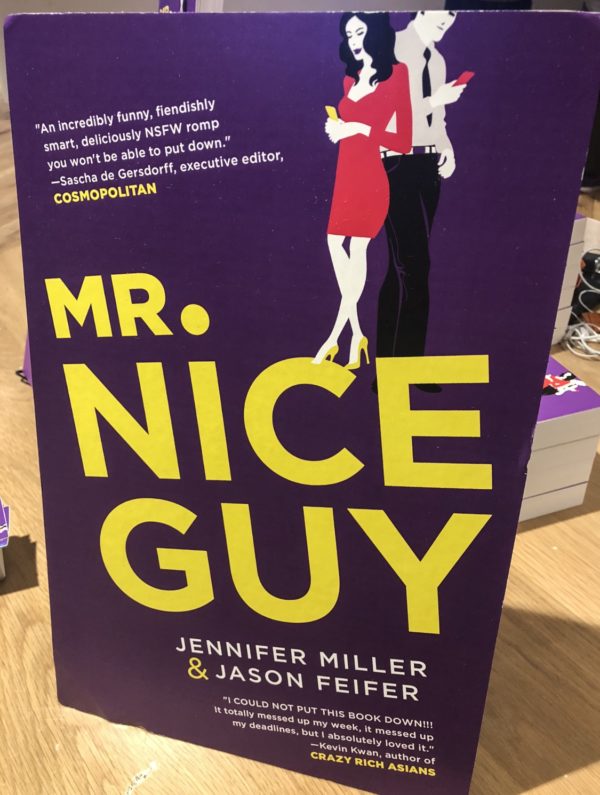
Kwan is not alone in his endorsement. Publisher’s Weekly calls Mr. Nice Guy a “witty romp through the allegedly glamorous world of magazines” that’s “sharp and satisfying” and “will have readers turning the pages quickly to get the latest dishy details.” And buckle up: Mr. Nice Guy may soon appear on the small screen!
Here’s a brief description of Mr. Nice Guy:
Lucas Callahan gave up his law degree, fiancée and small-town future for a shot at making it in the Big Apple. He snags an entry-level job at Empire magazine, believing it’s only a matter of time before he becomes a famous writer. And then late one night in a downtown bar he meets a gorgeous brunette who takes him home…
Carmen Kelly wanted to be a hard-hitting journalist, only to find herself cast in the role of Empire’s sex columnist thanks to the boys’ club mentality of Manhattan magazines. Her latest piece is about an unfortunate―and unsatisfying―encounter with an awkward and nerdy guy, who was nice enough to look at but horribly inexperienced in bed.
Lucas only discovers that he’s slept with the infamous Carmen Kelly―that is, his own magazine’s sex columnist!―when he reads her printed take-down. Humiliated and furious, he pens a rebuttal and signs it, “Nice Guy.” Empire publishes it, and the pair of columns go viral. Readers demand more. So the magazine makes an arrangement: Each week, Carmen and Lucas will sleep together… and write dueling accounts of their sexual exploits.
It’s the most provocative sexual relationship any couple has had, but the columnist-lovers are soon engaging in more than a war of words: They become seduced by the city’s rich and powerful, tempted by fame, and more attracted to each other than they’re willing to admit. In the end, they will have to choose between ambition, love, and the consequences of total honesty.

Stacy London interviewing Jennifer Miller and Jason Feifer.
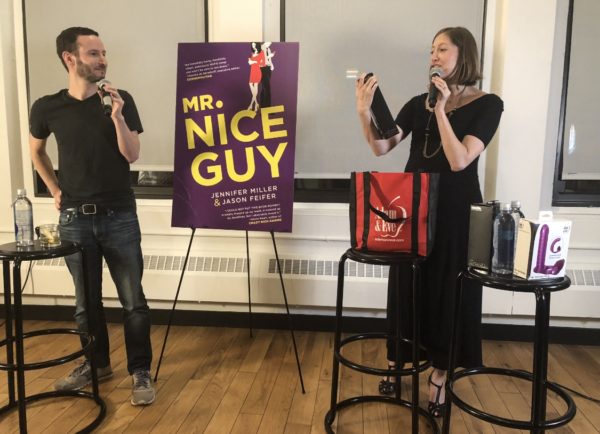
Feifer watching Miller dissect and discuss sex toys.
Miller and Feifer were kind enough to do a Q & A about their book and writing life. Here are some highlights:
What sparked the idea for this book, and was it always a given you’d work on it together?
Jason came up with the idea of having two people critique their sex lives like movie reviews years before we met. He’d been contacted by a younger writer who’d written the sex and relationships column for her college newspaper and wanted help breaking into professional journalism. During their (entirely vanilla) correspondence, Jason came up with the idea for Mr. Nice Guy. Over the years, he tried to start the book, but just didn’t feel comfortable writing fiction. What a boon that he married a novelist! He suggested that Jen take the idea if she liked it; she suggested they write the book together.
Was this the first project the two of you have worked on together? If yes, what was your process?
We frequently ask each other for professional advice and feedback. But Mr. Nice Guy was our first truly joint project. We developed the plot and characters together. Jen wrote the bulk of the narrative and Jason wrote all the columns. Then we edited each other’s work. We definitely weren’t typing over each other’s shoulders.
Did you have any hesitation sharing the intimacies of your relationship with readers and each other?
The book definitely forced us to open up about our dating and sex lives. It was actually a great way to discuss all that stuff—we had a reason to talk about it, which is a lot less awkward than simply saying over dinner, “so about last night’s sex…” Frankly, knowing that our parents would read this book was the most awkward aspect of the whole thing and is kind of horrifying.
What are the particular strengths each of you added to the novel?
Jen’s eye for detail and ear for satire captured the absurdity of NYC media culture and its brand of conspicuous consumption. Jason is great at turning conflict into comedy, which he did expertly in the columns written by our protagonists, Lucas and Carmen.
How excited are you to have sold the television rights to the novel? And who would you choose to star in the series?
OMG, so excited! It was amazing to have the producer of the movie Crash and the former head of NBC Universal on the phone outlining the first THREE seasons of our book-turned-TV show. Timothee Chalamet would make a great Lucas, our highly ambitious, sexually inexperienced male protagonist. Auli’i Cravalho would make a great Carmen.
Any more joint projects in the works?
We’ve plotted out a new novel about two political pundits on opposing sides who fall in love. Like last time, we plotted out the novel together. Jen is going to write the bulk of the narrative and Jason will write the couple’s contentious and absurd television appearances.
What will your 3-year-old son Fenn say about this book when he’s old enough to read it?
We hope that Fenn never reads this book!

For more about Mr. Nice Guy, visit Mr.NiceGuyNovel.com or Feifer’s website. The book is available wherever books are sold.
*Hosted by Hendricks Gin, Meltshop, The Balvenie, The Little Beet, Smart Water, Monkey Shoulder, and Fields Good Chicken.
by Elisa Zied | Aug 10, 2018 | books, fiction, writer, writers
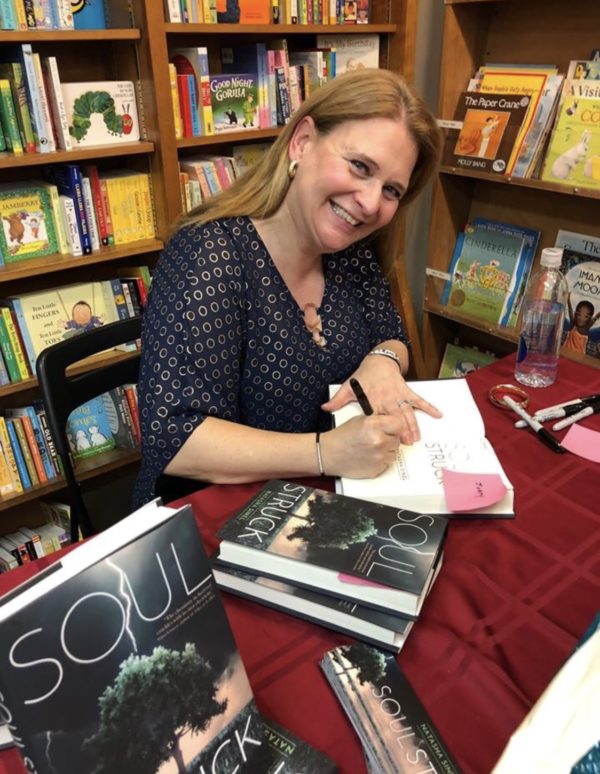 If you’re intrigued by the idea of soulmates and are fascinated by fate, Soulstruck (Sky Pony Press, June 12, 2018) may belong in your hands and on your bookshelf. Here’s a description of Natasha Sinel’s sophomore young adult novel:
If you’re intrigued by the idea of soulmates and are fascinated by fate, Soulstruck (Sky Pony Press, June 12, 2018) may belong in your hands and on your bookshelf. Here’s a description of Natasha Sinel’s sophomore young adult novel:
She might be only a lightning bolt away from finding her soul mate.
Seventeen-year-old Rachel Ferguson is trying to get struck by lightning. Maybe it will lead to finding her soul mate, like it did for her mother. And then maybe her mom will be as devoted to her as she is to her lightning strike survivors group.
When Rachel discovers letters written by her mother’s soul mate—the man she thought was her father—she begins to question everything she’s always believed, including soul mates, fate, and even her mother. No longer sure of its power, she decides to quit chasing lightning.
Rachel feels abandoned and alone—her best friend has ditched her, her boyfriend has dumped her, and confronting her mom only made things worse. At least she still has her friend Jay—in fact, their growing attraction to each other seems to be the only good thing happening.
But when her relationship with Jay starts to unravel too, the impulse to get struck by lightning resurfaces.
And there’s a thunderstorm coming.
Set in a small Cape Cod beach town in the off-season, SOULSTRUCK is about the search for love, and the risk of losing it while waiting for destiny to happen.
I had the pleasure of doing an email Q & A with Sinel. Read below to learn more about her and her writing life.
EZ: Now that you’re a seasoned novelist with two titles, how would you compare the process of writing your first novel, The Fix, with that of Soulstruck?
NS: A seasoned novelist? Ha! That’s super nice of you to say. While I did feel more confident this time around, writing a new novel still feels like starting from scratch. I think it’s safe to say that writing Soulstruck was just as difficult as writing The Fix! My novels have always started out as one thing and inevitably evolved into something very different. So I end up rewriting a few times as I discover my characters’ emotional arcs and the themes. It’s a long process, but so far it’s worked for me. I’m always looking for new processes to help streamline drafting and revising, but I usually end up doing what has always worked for me—basically, there’s no way out but through!
EZ: What’s the best thing you learned as a first-time author (related to writing, book promotion, etc.) that has helped you moving forward?
NS: I learned what a lot of debut authors learn—self-promotion is uncomfortable and it kind of sucks. Also, I’ve gotten much better at letting things go—like the little jealousies that arise about other authors getting sent to conferences or festivals, etc. I’m learning that sometimes it happens, and sometimes it doesn’t. Even with Soulstruck coming out, I’ve been much more focused on revising my current work in progress than on the release. I’m getting much better at doing what everyone says to do—just keep writing. The only thing we really have control over as authors is the writing.
EZ: What was the spark that lead to the idea that became Soulstruck?
NS: Back in 1991 there was a lightning strike at a high school lacrosse game in Washington, DC (where I’m from)—more than ten people were struck, and one teenager was killed. A young EMT who happened to be there saved several people’s lives that day. I wasn’t there but I’d heard about it and the story always stuck with me. An idea started to form in my head and as I researched lightning and the lightning strike survivors, my characters came into focus and my story began.
EZ: What was the most challenging part of writing Soulstruck?
NS: Some of my ideas in the beginning forced me toward a more paranormal storyline and, as I’m much more comfortable with realistic writing, it felt uncomfortable. I moved forward with it, though, because I remembered a former writing instructor saying it’s better to go big to start out and then you can always scale back. So that’s what I did. Though it was strange letting go of so much of the original idea I’d written, in the end, it was what was best for the story.
EZ: What was the best/most exciting or fulfilling part about writing Soulstruck?
NS: I always love those a-ha moments that come when you least expect it—as you’re falling asleep, taking a walk, in the shower. It makes me realize how hard my subconscious is working on my stories all of the time. One of my favorite moments was after I’d gotten some amazing editorial notes from my agent Linda Epstein, and I was in despair because the notes were BIG—like, really big. I let it all swirl around for a few days and then I got to work. I took out about 15k words. And added about 15k words. After I was finished, it was so much better, and when we sent it off to my editor, she loved it.
EZ: How did you get the idea for “Moving the Body,” your short story that appears in the recent adoption-themed anthology, Welcome Home? Was it something you had worked on before, or did you write it specifically for the anthology? And how excited were you to be asked (such an honor that must have been)!
NS: It was such an honor to be a part of Welcome Home. Eric Smith is amazing, and it was so wonderful to work with him. The anthology as a whole is really very special. And yes, I wrote Moving the Body specifically for the anthology! A few things came together to inspire the idea—one: I wanted to show that the bond between an adopted child and his mom can be as close as the bond between a biological child and his mom, two: I’d read a horrifying article about a teen in the UK who became involved with someone through an online game and the results were devastating, and three: right around the same time, there was an incident in my town—kids had spray-painted a swastika on a neighbor’s garage, and later it came out that a few of the kids were Jewish. Those three things did a little dance in my head, and out came my story.
EZ: Would you say you’re a one-book-at-a-time kind of author or can you work on multiple projects at once?
NS: So far, I work on one book at a time, though recently, when I was having difficulty with my work-in-progress, I wrote a few scenes for a new idea rather than skip a day of working. That was fun, and I could see myself doing that more.
EZ: Any advice for writers struggling to get their butts in the chair to just write?
NS: Ugh. It’s just so hard. There’s no way around it. Some things that help me are: 1. getting my butt in the chair right after putting my kids on the bus, so I don’t keep putting it off all day, 2. talking things out with my critique partner or setting up check-in times with her, 3. setting a timer for 25 minutes and committing to writing for just that amount of time—often, I’ll get on a roll and keep going, 4. writing a kissing scene or something I love even if it’s not the next scene I need to write. But some days, it just won’t happen. I try not to let it bring me down so I can start fresh the next day.
EZ: Anything exciting on the writing horizon for you?
NS: I’m finishing up a manuscript and getting ready to send it to my agent. I really have my fingers crossed for this one. And once I send it to her, I’ll get started on my next idea, which will require some research that I’m really excited about.
EZ: What’s currently on your book shelf?
NS: Lots of contemporary YAs: Monday’s Not Coming by Tifany D. Jackson, Foolish Hearts by Emma Mills, Sarah Dessen (I’m catching up on all of her books, way behind!), The Secret History of Us by Jessi Kirby, The Nowhere Girls by Amy Reed, and I can’t wait to read my agent-sister Miriam McNamara’s debut The Unbinding of Mary Read. I could go on…
EZ: Any favorite TV shows you’re currently enjoying?
NS: I read a lot more than I watch TV, but currently I’m watching The Handmaid’s Tale, Younger, and The Bold Type.
To learn more about Natasha Sinel and her work, visit her website here.
Full disclosure: Sinel’s publisher sent me an ARC of her book. I did, however, buy my own copy and cannot wait to get it signed!
by Elisa Zied | Aug 6, 2018 | books, writing
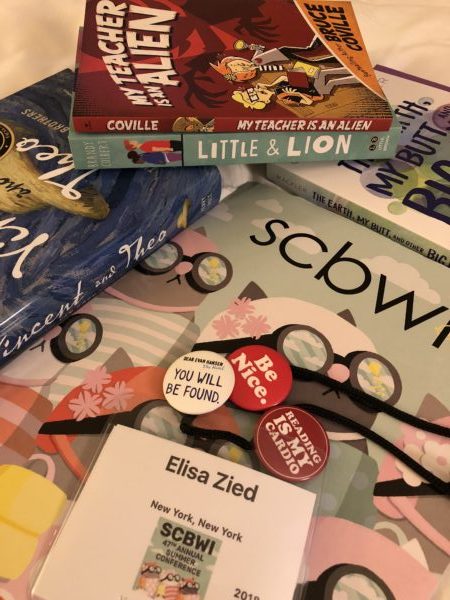 This weekend, I geeked out at the Society for Children’s Book Writers and Illustrators Summer Conference in Los Angeles, California. With homework and deadlines approaching, I was nervous about attending, wondering whether I could really afford to lose valuable study time. And of course I felt some Jewish mom guilt to leave my family less than a week after my 16-year-old returned from a summer program. Fortunately, I got a lot of reading and writing done on my 6-hour flight (with an additional hour on the runway). And while three full days of panels, workshops and keynotes with an amazing faculty of authors, agents and editors kept us busy, it was unbelievably inspiring and well worth every minute.
This weekend, I geeked out at the Society for Children’s Book Writers and Illustrators Summer Conference in Los Angeles, California. With homework and deadlines approaching, I was nervous about attending, wondering whether I could really afford to lose valuable study time. And of course I felt some Jewish mom guilt to leave my family less than a week after my 16-year-old returned from a summer program. Fortunately, I got a lot of reading and writing done on my 6-hour flight (with an additional hour on the runway). And while three full days of panels, workshops and keynotes with an amazing faculty of authors, agents and editors kept us busy, it was unbelievably inspiring and well worth every minute.
Besides making new friends, I spent quality time with a wonderful group of supportive and loving writer friends (several pictured below). I was also excited to see recent VCFA graduates and fellow students I had gotten to know—at least a little bit—during my recent grad school residency. Two even won awards—an Emerging Voices award for my fellow firstie at VCFA, Lakita Wilson, and a graduate award for recent VCFA grad Jessica Lee!) So, in many ways, coming to LA for this incredible conference felt like coming home.
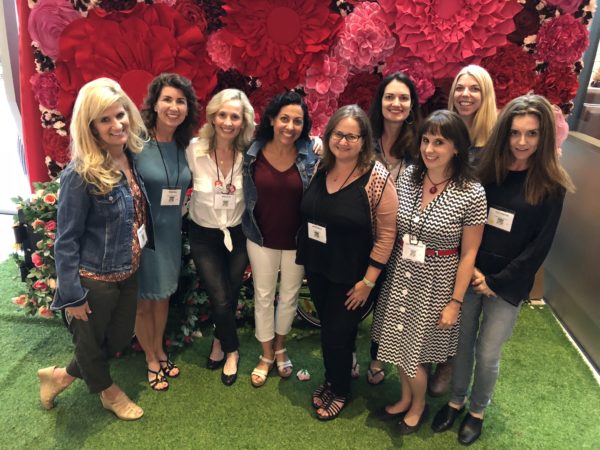
As always, I took full advantage of the conference, attending all but one keynote. The speakers were wonderful, especially Andrea Davis Pinkney and Brian Pinkney who put on a spirited and enjoyable show (such talent they both have), Libba Bray (a real writer’s writer), Lynda Mullaly Hunt and Bruce Coville (way to make me cry while touching and inspiring me), and Lois Lowry, the 81-years-young author of The Giver (pictured below while signing my book). I can’t wait to read her book about human connection set to launch in 2020.

There were so many highlights of the conference—too many to name. But I thought I’d share my top 10 takeaways list (in no particular order). I’m already thinking of when and how to incorporate many of these ideas into my writing/life, and invite my writer friends to do so as well.
10. Daniel Jose Older, author of Shadowshaper: The sound and rhythm of words matter. Read work aloud so you can hear it.
9. Elana K. Arnold, author of What Girls Are Made Of:
- Tension is the spinal cord of books. Increase tension by asking What if questions, play with time, add a ticking clock, and/or write your character into a corner that you don’t know how to get her out of.
- Think of ten scenes that are integral to your novel and write them. Write one sentence at a time.
8. Lynda Mullaly Hunt, author of Fish in a Tree:
- You pass by ideas every single day. When you feel emotion, jot it down (or talk into your phone about it).
- Write what you’re ashamed of…what you don’t want anyone to know, what you haven’t yet figured out.
7. Andrea Davis Pinkney, author of The Red Pencil: Meet hate with love. Every morning, spend some time thinking of things that make you happy. Then write.
6. Amanda Maciel, author of Tease: Who does your protagonist think she is, and what do other people think she is? What are the expectations placed on her? And who is she beyond those expectations? What’s important to her? Assess everything from her eyes.
5. Libba Bray, author of The Diviners: What is the purpose of your story, the spark that lights the fuse? What answer do you seek? The question is about growth…bringing us somewhere. Push aside vanity and the desire to be liked and write from a deep, vulnerable place. Do not think about how the story will be received.
4. Erin Entrada Kelly, author of Hello, Universe:
- We were never kids’ age in the age of technology. Don’t think about kids through the lens of your teen years. Use the emotions you felt in your childhood years, but learn and understand what their world looks like today.
- When revising, ask, “Why is this here? What is this scene/chapter/sentence doing here?
3. Eliza Wheeler, author/illustrator of Miss Maple’s Seeds:
- We confuse our identities with our work. The work is not us.
- The real goal in creating art is to love the process so much that you want to show up to do the work.
2. Bruce Coville, author of My Teacher is An Alien:
- Why do you want to write? Keep asking the whys. Then you’ll understand and it’ll inform your work.
- Small actions ripple the world and small gestures can be a turning point.
- Do not start writing books with a message. Start with your own good heart.
1. Here are just a few of the books I’m adding to my TBR list as a result of attending this conference:
- My Teacher is an Alien by Bruce Coville
- The Earth, My Butt, and Other Big Round Things by Carolyn Mackler
- Little and Lion by Brandy Colbert
- Vincent and Theo: The Van Gogh Brothers by Deborah Heiligman
- Out of Wonder: Poems Celebrating Poets by Kwame Alexander with Chris Colderley and Marjory Wentworth, illustrated by Ekua Holmes
If you attended the SCBWI Summer Conference, what were your takeaways?
To learn more about the conference—and about SCBWI, an organization I’m SO proud to be part of—visit the website here.
by Elisa Zied | Jul 26, 2018 | books, fiction
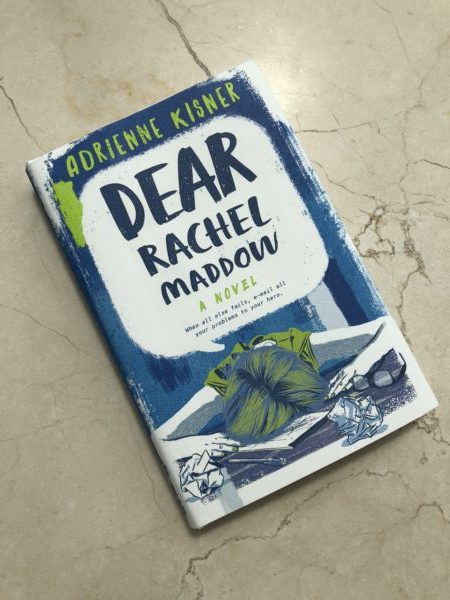 When I learned a friend of friend wrote a book called Dear Rachel Maddow, I was overjoyed. A big fan of The Rachel Maddow Show which airs weeknights on MSNBC at 9:00 P.M., I often joke the show is the glue to my marriage.*
When I learned a friend of friend wrote a book called Dear Rachel Maddow, I was overjoyed. A big fan of The Rachel Maddow Show which airs weeknights on MSNBC at 9:00 P.M., I often joke the show is the glue to my marriage.*
Here’s a description of Adrienne Kisner’s debut young adult book, Dear Rachel Maddow, from Amazon:
Brynn Haper’s life has one steadying force–Rachel Maddow. She watches her daily, and after writing to Rachel for a school project–and actually getting a response–Brynn starts drafting e-mails to Rachel but never sending them. Brynn tells Rachel about breaking up with her first serious girlfriend, about her brother Nick’s death, about her passive mother and even worse stepfather, about how she’s stuck in remedial courses at school and is considering dropping out.
Then Brynn is confronted with a moral dilemma. One student representative will be allowed to have a voice among the administration in the selection of a new school superintendent. Brynn’s arch nemesis, Adam, and ex-girlfriend, Sarah, believe only Honors students are worthy of the selection committee seat. Brynn feels all students deserve a voice. When she runs for the position, the knives are out. So, she begins to ask herself: What Would Rachel Maddow Do?
Although I had never read an epistolary novel before, I so enjoyed Kisner’s book. I found the format to be an effective way to tell Brynn’s story. Her struggles in school–and in the context of her family–were compelling, and the humor sprinkled throughout the novel was a nice touch that drew me in. Despite the book’s title, Kisner does not beat readers over the head with politics; instead, she seamlessly weaves in subtle descriptions of Maddow’s personality and show to support Brynn’s admiration for her.
Kisner was kind enough to do an email Q & A about the book and her writing life. Here are the highlights.
Zied: I read on your blog that you were inspired to write Dear Rachel Maddow after having your first child aka Screamy Baby. Can you elaborate?
Kisner: I live on a college campus. Our cable television was great for late-night-don’t-sleep types until one sad day right after my daughter was born. They took away the WE network and I didn’t really know what to do with myself. I aimlessly flipped until I settled on our new assortment of myriad news channels. Rachel Maddow repeated at least twice a night . . . possibly more, my memory from those days is dream-like. Then I discovered her podcast where I could listen to her while doing chores. Things are always new when your short term memory is shot from sleep deprivation. So it’s like it didn’t even repeat.
Zied: What is it about Rachel Maddow that led you to make her someone your protagonist reveres/reaches out to (if mainly in spirit)?
Kisner: Rachel is so smart and civil and engaged in this world. All the things my main character does not think herself to be, but to which she really aspires deep down. Rachel’s often really funny on her show, too. How can you not like that? (I mean, I know it’s possible. I’ve seen Twitter. But still.)
Zied: To write the book, did you plot or pant, or do some combination of both?
Kisner: I’m a pantser, all the way. Plotting baffles me.
Zied: Did you have a specific schedule/routine while writing this book?
Kisner: None. I have to squeeze in writing whenever I can, around work and family and stuff. I’d have an hour one day, fifteen minutes the next, none for two weeks.
Zied: When and how did you decide to use the epistolary format to write this book?
Kisner: Initially I’d planned to really rip off the Dear Mr. Henshaw format—write half of it in letters, then go to more of a journal. And it sort of goes like that. But Brynn, the main character, wouldn’t really write in a journal. I think she wanted to connect with someone, outside herself. She’d only write (or dictate) if it were to someone else.
Zied: You hold both a master’s and doctorate degree in theology. How do you think your studies have informed or influenced your book (if at all)?
Kisner: I don’t know. The longer I went on studying faith, the more I became convinced that people who claim to know God’s will, probably don’t. Mystery and faith seeking understanding and dialogue are stressed in the circles I run in. Here, notions of what “sin” is become more situated in the unknowable mind of God, so I got more and more pissed off that the government should try to legislate off the unknowable mind of God. If anything, the excessive amount of time I spent studying theology gave me a true appreciation for the importance of the Establishment Clause and the Free Exercise Clause in the First Amendment. That people are screwing with that in the name of the ineffable is infuriating and dangerous.
Zied: What made you want to write novels for teens?
Kisner: Teens are awesome. I don’t understand why everyone doesn’t write for teens. I assume people who write for adults do so because writing for kids is too hard.
Zied: How did your MFA studies at Vermont College of Fine Arts** help prepare you both creatively and professionally to become a young adult novelist?
Kisner: VCFA gave me a community of writers, many of whom are now my best friends. I’ve had other people simply stop talking to me because I was too much or not enough or something tied to my life as a creator of things. That sucked. The inevitable ups and downs of the industry make for a wild ride, too. VCFA gave me lectures to polish my craft, but also gave me mentors and friends who are always in my corner. I love them all.
Zied: Have you shared your book with Rachel Maddow (if she’s anything like I’d suspect, she’d be flattered not to mention gracious).
Kisner: Welllll . . . I think she got an ARC? Lol. Not from me, per se. Because she is a real person whose name is on this thing that I wrote. I honestly wrote it thinking it would be another novel that no one would ever see (like so many of my novels before it). So when it was the one that sold, I thought she should be allowed the space to ignore it entirely. I have no doubt she’s lovely. But I don’t try to push it. I don’t want her to feel like she ought to be gracious. Fame has to be wearing enough without one more thing. (Though I have friends who @ her on Twitter. I do think that’s kind of funny, I admit.)
Zied: What’s next for you?
Kisner: A book about girl birders. I think of it as “Dear Rachel Maddow” meets “The Big Year.” I have dream goals of inspiring a few readers to both vote and go birding.
*My like-minded husband and I love Rachel’s ability to tell stories and give context to the ever-changing state of the union. Especially now!
**I began my MFA studies at VCFA in July. Read about my writing journey here.
To learn more about Dear Rachel Maddow and Kisner’s work, visit her website here.




 If you’re intrigued by the idea of soulmates and are fascinated by fate, Soulstruck (Sky Pony Press, June 12, 2018) may belong in your hands and on your bookshelf. Here’s a description of Natasha Sinel’s sophomore young adult novel:
If you’re intrigued by the idea of soulmates and are fascinated by fate, Soulstruck (Sky Pony Press, June 12, 2018) may belong in your hands and on your bookshelf. Here’s a description of Natasha Sinel’s sophomore young adult novel: This weekend, I geeked out at the Society for Children’s Book Writers and Illustrators Summer Conference in Los Angeles, California. With homework and deadlines approaching, I was nervous about attending, wondering whether I could really afford to lose valuable study time. And of course I felt some Jewish mom guilt to leave my family less than a week after my 16-year-old returned from a summer program. Fortunately, I got a lot of reading and writing done on my 6-hour flight (with an additional hour on the runway). And while three full days of panels, workshops and keynotes with an amazing faculty of authors, agents and editors kept us busy, it was unbelievably inspiring and well worth every minute.
This weekend, I geeked out at the Society for Children’s Book Writers and Illustrators Summer Conference in Los Angeles, California. With homework and deadlines approaching, I was nervous about attending, wondering whether I could really afford to lose valuable study time. And of course I felt some Jewish mom guilt to leave my family less than a week after my 16-year-old returned from a summer program. Fortunately, I got a lot of reading and writing done on my 6-hour flight (with an additional hour on the runway). And while three full days of panels, workshops and keynotes with an amazing faculty of authors, agents and editors kept us busy, it was unbelievably inspiring and well worth every minute.

 When I learned a friend of friend wrote a book called
When I learned a friend of friend wrote a book called
Recent Comments